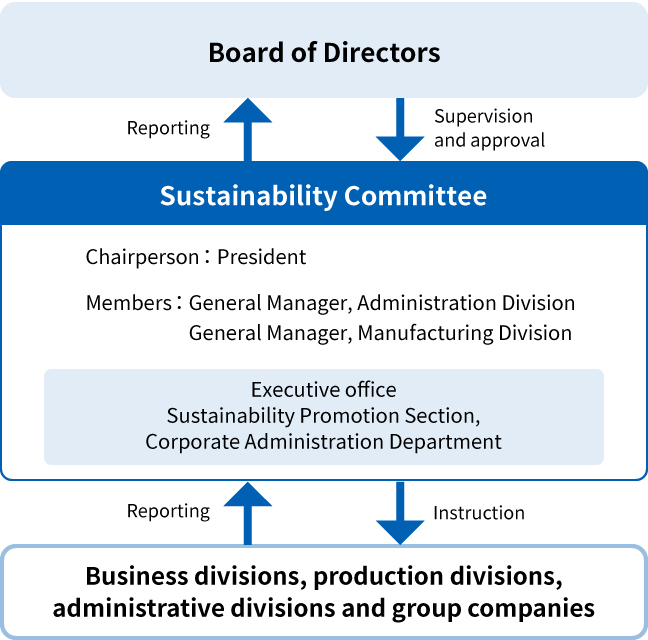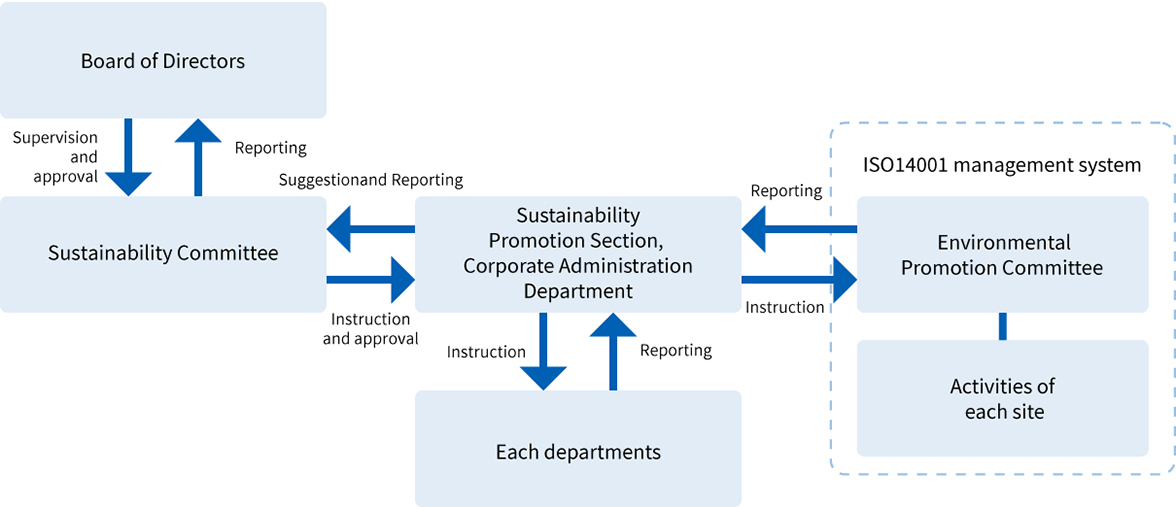Information Disclosure Based on TCFD Recommendations
- TOP
- Sustainability
- Information Disclosure Based on TCFD Recommendations

Our company has positioned responding to climate change as an important issue in our business strategy, and in December 2023, we announced our support for The Task Force on Climate-related Financial Disclosures (TCFD). We will disclose information based on the common global framework for disclosure of climate-related information specified by the TCFD.
Governance

In March 2023, we established the Sustainability Committee, which is chaired by the President.
The Sustainability Committee deliberates on issues such as tackling climate change, and the committee has a system for reporting its decisions to the Board of Directors.
In order to manage whether we are steadily fulfilling our targets, the Sustainability Committee will play a central role in working toward achieving these targets when there is a discrepancy between targets and actual values, or when there is room for improvement.
Strategy
We conduct scenario analysis to clarify the long-term risks and opportunities posed by climate change. In analyzing the 1.5℃ scenario, we assumed that decarbonization policies would be strengthened in each country and region, and the impact on the industries in which our company is involved. In addition, in the analysis of the 4°C scenario, it was found that decarbonization policies are not strengthened in each country and region in response to climate change, and as average temperatures continue to rise and natural disasters become more severe, physical risks will increase.
1.5℃ scenario
Various regulations regarding carbon neutrality have been strengthened, and companies and local governments are actively working on renewable energy and energy conservation in order to create a sustainable society.
| Opportunities And Risks | Classification | Business Impact | Impact |
|---|---|---|---|
| Opportunities | Popularization of next-generation vehicles | Expansion of connector and semiconductor markets due to increasing demand for next-generation mobility such as electric vehicles | High |
| Power saving of communication infrastructure | Increase in demand for connectors due to server construction using power-saving electronic devices | High | |
| Replacement with energy-saving equipment | Increased demand for semiconductors due to power control and control through power saving | High | |
| Promoting the use of renewable energy | Increase in demand for semiconductors due to promotion of renewable energy use | Middle | |
| Transition Risks | National policies | Factory operation stoppage due to power control | High |
| Increase in costs due to introduction of decarbonization tax | High | ||
| Increase in cost due to emission allowance purchase | Middle | ||
| Risk of incurring costs for switching to renewable energy equipment | Middle | ||
| Increase in industrial waste treatment costs | Low | ||
| customer requests | Opportunity loss due to delay in responding to needs for decarbonization | Middle |
4.0℃ scenario
The current situation is that no measures are taken to prevent temperature rise, increasing the risk of natural disasters.
| Risks | Classification | Business Impact | Impact |
|---|---|---|---|
| physical Risks | Increase in occurrence of abnormal weather | Increased costs due to difficulty in obtaining raw materials | High |
| Operation stoppage due to factory damage | High | ||
| Rise in average temperature | Rise in utility costs | Middle | |
| Reducing factory operation | Middle |
Risk Management

Our group has organized an environmental management system based on ISO 14001, with the Environmental Promotion Committee taking the lead in identifying environmental risks and allowing each departments to proceed with initiatives in line with their goals. Additionally, we visualize internal indicators for progress management, promote environmental initiatives, and strengthen our management system.
Metrics and Targets
We would like to inform that Yamaichi Electronics group aims to reduce CO2 emission by 40% in 2030, compared to the basic unit per consolidated sales revenue of the fiscal year 2021. We will also try to meet carbon neutrality in 2050.
*Our CO2 emissions intensity is the CO2 emissions per consolidated sales revenue.
Actual result of CO2 emissions per unit in 2021 : 0.36t/million yen

